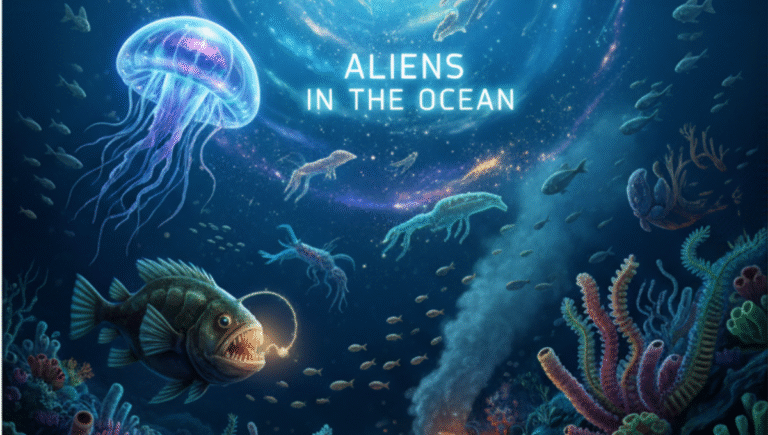When people think of “aliens,” the first image that comes to mind is often outer space—distant planets, flying saucers, and beings from beyond the stars. Yet, one of the most fascinating frontiers of possible “alien” life may be much closer to home: the depths of Earth’s oceans.
The ocean is often called Earth’s final frontier, with more than 80% still unexplored. Within its dark and pressurized depths live creatures so strange and otherworldly that scientists often refer to them as “alien-like.” But beyond biological oddities, there are also long-standing myths and theories suggesting that extraterrestrial life may actually reside in the ocean itself.
In this article, we’ll explore the mysteries of aliens in the ocean, from bizarre deep-sea lifeforms to theories of hidden underwater civilizations and what these mysteries can teach us about life beyond Earth.
The Ocean: Earth’s Own Alien World
The deep ocean is unlike any other environment on the planet:
-
Extreme pressure makes survival nearly impossible for most known species.
-
Complete darkness dominates below 1,000 meters, forcing life to adapt in strange ways.
-
Cold temperatures create harsh conditions similar to extraterrestrial environments.
These extreme conditions create ecosystems that look more like science fiction than reality. The ocean floor, in many ways, is a natural laboratory for studying what life might look like on other planets or moons.
Alien-Like Life in the Deep Sea
The deep ocean is home to some of the strangest creatures ever discovered. Many look and behave in ways that seem almost extraterrestrial:
1. Anglerfish
With a glowing lure protruding from its head, the anglerfish lives in darkness where it uses bioluminescence to attract prey—an adaptation that feels straight out of a space horror movie.
2. Giant Squid
Once thought to be mythological, these enormous creatures can grow over 40 feet long. Their massive eyes, among the largest in the animal kingdom, are perfectly adapted for detecting light in the deep sea.
3. Hydrothermal Vent Creatures
Near undersea volcanic vents, strange tube worms, shrimp, and crabs thrive without sunlight, feeding on chemical energy—a process called chemosynthesis. This is a key discovery because it shows life doesn’t always need sunlight, expanding the possibilities for life on other planets.
4. Deep-Sea Jellyfish and Ctenophores
With transparent bodies and glowing patterns, these creatures resemble living UFOs drifting silently in the abyss.
Could Extraterrestrials Be Hiding in the Ocean?
Beyond Earth’s unique marine life, some researchers and theorists argue that extraterrestrial life forms may actually live in our oceans. This idea, though controversial, is based on several points:
-
Unidentified Submersible Objects (USOs): Reports of strange lights and fast-moving objects underwater have fueled speculation about alien technology in the sea.
-
Oceans as Safe Havens: If aliens wanted to remain undetected, the deep ocean—vast, unexplored, and difficult to monitor—would be the perfect hiding place.
-
Ancient Myths and Legends: Stories of aquatic gods, underwater cities like Atlantis, and sea monsters suggest that humanity has long associated the ocean with mysterious, possibly alien beings.
While there’s no scientific proof of extraterrestrial life underwater, the theory continues to intrigue both researchers and enthusiasts.

The Connection Between Oceans and Space
Interestingly, exploring the ocean helps us understand what alien life might look like elsewhere. Worlds like Europa (a moon of Jupiter) and Enceladus (a moon of Saturn) are believed to have vast subsurface oceans beneath layers of ice.
If Earth’s oceans can sustain such bizarre and resilient creatures, it raises an exciting question: could similar alien life exist in the oceans of other planets or moons?
The study of deep-sea organisms, especially those thriving without sunlight, directly informs the search for extraterrestrial life in our solar system.
Lessons from the Deep: What Ocean “Aliens” Teach Us
The exploration of deep life offers profound lessons:
-
Life Can Thrive in Harsh Environments
– From hydrothermal vents to crushing pressures, deep-sea species show that life finds a way in conditions once thought impossible. -
Alien Doesn’t Always Mean Extraterrestrial
– Many ocean species look “alien” simply because they are so different from surface life. Studying them expands our understanding of biology. -
Exploring Earth Prepares Us for the Stars
– By studying the mysteries of our oceans, we improve our tools and knowledge for detecting life on distant planets.
Final Thoughts
The phrase “aliens in the ocean” is more than just science fiction—it’s a window into two great mysteries: the hidden world of Earth’s deep seas and the possibility of life beyond our planet. Whether we’re talking about strange deep-sea organisms or theories of extraterrestrial beings hiding underwater, one thing is certain: the ocean is as mysterious and awe-inspiring as outer space itself.
As technology improves and we continue to explore both the seas and the stars, we may find that the line between alien life on Earth and life beyond Earth is much thinner than we once believed.
